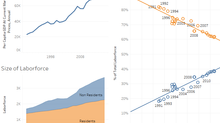Navigating the GenAI Revolution: A Guide for Organizations

The last decade has seen an explosion of data-driven technologies, from Hadoop, R, and Python to Tableau, Qlik, and PowerBI. More recently, Generative AI (GenAI) tools like ChatGPT, Claude, Gemini, and Deepseek have entered the scene, sparking a transformative debate: can technology enhance worker productivity, or will it replace employees altogether? While the answer is nuanced, one thing is clear—GenAI is reshaping how work gets done, but not necessarily what needs to be done.
However, the rapid pace of innovation has left many organizations and professionals overwhelmed. Investments in learning and adopting new technologies often erode quickly as newer tools emerge. The fear of missing out (FOMO) has led many to chase the "next shiny thing," resulting in a lack of direction and clarity. To navigate this complex landscape, organizations need a structured approach to assess the impact of GenAI, choose the right tools, and redesign workflows effectively.
Understanding the Scope of Impact

Not all industries and roles will be impacted equally by GenAI. Work that is digitized and repetitive is increasingly being automated, freeing employees to focus on higher-value tasks. However, many sectors—such as plumbing, construction, manufacturing, and skilled trades—will continue to rely on human expertise for tasks requiring dexterity, experience, and complex decision-making.
For organizations, the key lies in identifying which tasks are ripe for automation and which require the human touch. This requires a clear understanding of the organization’s workflows and the specific value that GenAI can bring.
Choosing the Right Tool for the Right Problem
When it comes to digitized problems, there are two broad categories: those with a single right answer and those with multiple possible solutions.
Problems with a Single Right Answer: Tasks such as mathematical calculations, optimizing system settings, or data analysis have long been the domain of machine learning and analytics. Organizations have made significant strides in automating these tasks.
Problems with Multiple Right Answers: GenAI excels in solving problems that require creativity, such as creating marketing copy, social media posts, conducting literature reviews, or translating scripts. Its ability to generate drafts quickly and iterate improvements at lightning speed has shifted the human role from execution to direction-setting and quality assurance.
Organizations must carefully evaluate which category their challenges fall into and determine how GenAI can best support their goals.
Redesigning Workflows for the GenAI Era
To fully realize the benefits of GenAI, workflows must be redesigned with AI in mind. This requires making several critical decisions:
Choosing the Right GenAI Platform: With options like Deepseek, ChatGPT, and others evolving rapidly, organizations must select a platform that aligns with their needs. While the low cost of subscriptions and similarities in functionality make it tempting to wait, delaying adoption can mean missing out on competitive advantages.
Task Allocation: Deciding which tasks should leverage GenAI and which are better suited to humans is critical. This requires a deep understanding of both the technology and the organization’s unique context.
Talent Redefinition: Redesigning roles to integrate GenAI means rethinking who is best suited for these new, enhanced positions.
Organizations should start small, experiment with pilot projects, and scale successful initiatives across teams or departments. Encouraging a culture of experimentation and continuous learning is key to staying ahead in the GenAI era.

Measuring Success in a GenAI-Enhanced Environment
As workflows evolve, so too must the metrics used to measure success. Organizations should focus on outcomes rather than processes, ensuring that outputs—whether human or AI-generated—achieve their intended goals. This may involve redefining performance metrics and providing employees with the training and support they need to thrive in a GenAI-enhanced environment.
Navigating the GenAI Landscape
The GenAI revolution is here, and the time to act is now. By understanding the scope of impact, choosing the right tools, and redesigning workflows, organizations can harness the full potential of GenAI to drive productivity, creativity, and growth.
If you’re interested in exploring how GenAI can transform your organization, FYT Consulting Pte Ltd is here to help. Visit us at www.fytconsultants.com to learn more about our expertise in GenAI adoption, workflow redesign, and training. Let us help you turn the promise of GenAI into reality.
By taking a structured and thoughtful approach, organizations can navigate the GenAI revolution with confidence and clarity. The future of work is evolving—make sure your organization is ready.

























コメント